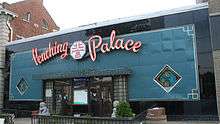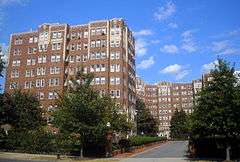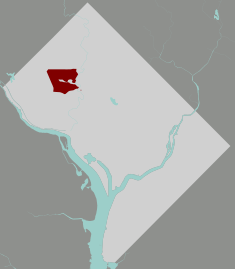Cleveland Park
|
Cleveland Park Historic District | |
|
The Broadmoor Apartments | |
|
Map of Washington, D.C., with Cleveland Park highlighted in maroon. | |
| Location | Roughly bounded by Tilden Street, Connecticut Avenue, Klingle Road, and Wisconsin Avenue, Washington, DC |
|---|---|
| Built | 1886 |
| Architect | Francis R. Allen; Et al. |
| Architectural style | Bungalow/craftsman, Italianate, Queen Anne |
| NRHP Reference # | 87000628 [1] |
| Added to NRHP | April 27, 1987 |
Cleveland Park is a residential neighborhood in the Northwest quadrant of Washington, D.C. It is located at 38°56′11″N 77°3′58″W / 38.93639°N 77.06611°W and bounded approximately by Rock Creek Park to the east, Wisconsin and Idaho Avenues to the west, Klingle and Woodley Roads to the south, and Rodman and Tilden Streets to the north.[2][3] Its main commercial corridor lies along Connecticut Avenue, NW, where the eponymous Cleveland Park station of the Washington Metro's Red Line can be found; another commercial corridor lies along Wisconsin Avenue. The neighborhood is known for its many late 19th century homes and the historic Art Deco Uptown Theater. It is also home to the William L. Slayton House and the Park and Shop, built in 1930 and one of the earliest strip malls.[4]
History
The first American settler was General Uriah Forrest, an aide-de-camp of George Washington who built an estate called Rosedale (now at 3501 Newark Street) in 1793, when he began serving as a Congressman from Maryland. Later, it housed Youth For Understanding, an international student exchange organization. In 2002, the Rosedale grounds were placed in a public conservancy,[5] and the farmhouse, said to be the oldest house in Washington, returned to residential use. Other estates followed. Gardiner Greene Hubbard, first president of the National Geographic Society, built the colonial Georgian revival Twin Oaks on 50 acres (200,000 m²) in 1888. It was used as a summer home by the Hubbard family, including Alexander Graham Bell and is today home of the diplomatic mission of the Republic of China on Taiwan. Tregaron, present-day home of the Washington International School, is a Georgian house built in 1912.
The neighborhood acquired its name after 1886, when President Grover Cleveland purchased a stone farmhouse directly opposite Rosedale and remodeled it into a Queen Anne style summer estate called Oak View or Oak Hill (by other accounts, Red Top). When Cleveland lost his bid for re-election in 1888, the property was sold, and the Oak View subdivision was platted in 1890.[6]:2 The Cleveland Heights subdivision was platted around the same time,[6]:2 and the Cleveland Park subdivision soon thereafter.[6]:4[7]
Early large-scale development was spurred by the neighborhood's upland topography, which provided a breezy relief from the hot, fetid air in the lowlands that were then the built-up area of Washington, D.C. Most of the houses built during this period show their intended use as summer houses in the era before air conditioning, having such architectural features as wide porches, large windows, and long, overhanging eaves.[6]
While the first subdivisions were made in response to the extension of the Georgetown and Tennallytown electric streetcar line along Wisconsin Avenue, the success of the neighborhood was the result of the Rock Creek Railway, built on Connecticut Avenue in 1892.[6]:2 Once Cleveland Park was connected to downtown Washington, the neighborhood's second phase of development, as a "streetcar suburb", began. The Cleveland Park Company oversaw construction on numerous plots starting in 1894.[6] Most houses were designed by individual architects and builders, including Waddy B. Wood, resulting in an eclectic mix of the popular architectural styles of the time, notably the Queen Anne style (including the Shingle style), Georgian Revival, and the Mission Revival.[6]:7 In later years, simpler schools of design such as the Prairie style and Tudor Revival came to dominate.

Development proceeded in fits and starts, punctuated by such events as the bankruptcy of the Cleveland Park Company in 1905[6]:9 and the Great Depression in the 1930s. As a result, houses of very different sizes, natures, and styles can often be seen next to one another. In the later 20th century, Winthrop Faulkner and I. M. Pei designed houses in the neighborhood as well.[6]:11–12
Civic Groups
The Cleveland Park Citizens Association (CPCA) was established in 1911 by residents of the Cleveland Park area. The Association was incorporated in 1964 as the "Connecticut Avenue Citizens Association." The name was changed in 1966 to the current name, Cleveland Park Citizens Association. Over the years, it has raised money for the construction of the local library branch, the Cleveland Park Neighborhood Library.[8] It is a member of the Federation of Citizens Associations of the District of Columbia.
The Cleveland Park Historical Society, founded 1985, strives to document and preserve the history and architecture of the neighborhood, and especially the historic district, which was designated in 1987. The Society sponsors an annual house tour in the neighborhood.
The Cleveland Park Club was founded in 1922 to "promote social intercourse, recreation and sports, literature and the arts, and for mutual improvement" of the neighborhood in the days before television and widespread broadcasting and movies. The next year, the Club purchased a 1900 house to use as its base. Events included such entertainment as plays, songfests, and dances. With the construction of a swimming pool, the Club became more centered on recreational swimming, although other activities, including annual potluck suppers on Memorial Day and Labor Day, a day camp, and other occasional social and educational events continue.[9]
Education
District of Columbia Public Schools operates public schools. Zoned high schools include:
- Elementary schools: Phoebe Hearst Elementary and John Eaton Elementary[10]
- Woodrow Wilson High School[11]
The Washington International School operates an upper-school campus (located on the Tregaron estate) in the neighborhood, located off of Macomb Street between Connecticut Avenue and Reno Road. The National Child Research Center operates a nursery school in the neighborhood;[12] National Cathedral School, St. Albans School, and Sidwell Friends School are located at the edge of the customary boundary of Cleveland Park.
The District of Columbia Public Library system operates the Cleveland Park Neighborhood Library.[13]
Residents
- David Brooks, New York Times columnist[14]
- Al Hunt, columnist for Bloomberg View, and Judy Woodruff, television news anchor and journalist[15]
- Jim Lehrer, journalist and novelist[15]
- Ana Montes, Defense Intelligence Agency employee who spied for Cuba[16]
- Marjorie Townsend (1930-2015), NASA engineer
- David Ignatius, journalist and author
Notes
- ↑ National Park Service (2007-01-23). "National Register Information System". National Register of Historic Places. National Park Service.
- ↑ map http://www.clevelandparkisus.org/maplinks.htm
- ↑ map http://www.clevelandparkdc.org/histdist.htm
- ↑ Willman, John B., "Washington's Original Shopping Center Sold", The Washington Post & Times-Herald, Wednesday 30 January 1963, Volume 86, Number 56, page B-7.
- ↑ The Rosedale Conservancy (2013). "Rosedale's History". Retrieved 2013-06-01.
- 1 2 3 4 5 6 7 8 9 Kimberly Prothro Williams, Cleveland Park Historic District brochure, D.C. Preservation League, 2001.
- ↑ Map of the District of Columbia, Showing public reservations and possessions, etc., McMillan Commission Map D-289, 1901.
- ↑ "Cleveland Park Neighborhood Library". District of Columbia Public Library. Archived from the original on 2008-02-02. Retrieved 2007-09-17.
- ↑ Cleveland Park Club, "About the Club".
- ↑ "Attendance Zones for Neighborhood Elementary & K-8 Schools S.Y. 2013-2014" (Archive). District of Columbia Public Schools. Retrieved on April 14, 2015.
- ↑ "Attendance Zones for Neighborhood High Schools S.Y. 2013-2014" (Archive). District of Columbia Public Schools. Retrieved on April 14, 2015.
- ↑ National Child Research Center, Welcome to National Child Research Center Preschool; accessed 2012.09.02.
- ↑ "Hours & Locations." District of Columbia Public Library. Retrieved on October 21, 2009.
- ↑ Trotter, J.K. (November 6, 2014). "Would-Be Divorcé David Brooks Bought a $1.9 Million Home With His Wife". Gawker. Archived from the original on February 19, 2015. Retrieved February 16, 2015.
- 1 2 >Andrews, Helena (September 16, 2014). "New York Times columnist David Brooks sells his $4.5 million home in less than 48 hours". The Washington Post. Retrieved February 16, 2015.
- ↑ Popkin, Jim. "Ana Montes did much harm spying for Cuba. Chances are, you haven’t heard of her." The Washington Post. April 18, 2013. Retrieved on February 3, 2014.
External links
| Wikimedia Commons has media related to Cleveland Park, Washington, D.C.. |
- Cleveland Park Citizens Association
- Cleveland Park Historical Society
- Cleveland Park Club
- Why Is It Named Cleveland Park?
- Cleveland Park Congregational United Church of Christ
- National Register of Historic Places: Cleveland Park Historic District
- Cleveland Park Email List
- StationMasters Online: Cleveland Park Neighborhood Map
- The Washington Post's Neighborhood Profile: Cleveland Park Profile
 |
Tenleytown | Forest Hills |  | |
| McLean Gardens Cathedral Heights |
|
Rock Creek Park | ||
| ||||
| | ||||
| Massachusetts Heights | Woodley Park | National Zoo |

